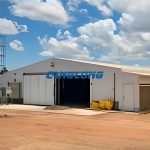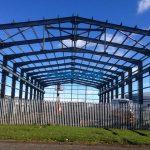Application of steel agricultural buildings: a new trend in the development of modern agriculture
With the advancement of science and technology and the development of modern agriculture, traditional agricultural buildings are gradually being replaced by more efficient and environmentally friendly steel agricultural buildings. Steel agricultural buildings play an increasingly important role in the agricultural field with their unique advantages, such as high strength, corrosion resistance, and ease of construction.
Characteristics of Steel Agricultural Buildings
Steel agricultural buildings use steel as the main structural material and have the following salient features:
- High strength: Steel has high strength and can withstand larger loads, making steel agricultural buildings more stable and safe.
- Corrosion resistance: The steel surface has been specially treated to have good corrosion resistance, which can resist corrosive factors in the natural environment and extend the service life of the building.
- Easy to construct: Steel processing precision is high, factory production can be realized, and on-site installation is simple and fast, greatly shortening the construction period.
- Environmental protection and energy saving: Steel agricultural buildings generate less waste during the construction process and have a high recycling rate, which is in line with the development trend of green buildings.

Applications of Steel Agricultural Buildings
Steel agricultural buildings are widely used in agricultural production, mainly including the following aspects:
- Greenhouse: Steel frame greenhouse is one of the important applications of steel agricultural buildings. Its stable structure, good lighting and excellent thermal insulation properties provide a good growing environment for crops. At the same time, steel frame greenhouses can flexibly adjust their structural forms according to the growth needs of different crops to achieve efficient and energy-saving agricultural production.
- Breeding facilities: In the breeding industry, steel agricultural buildings also play an important role. Architectural forms such as steel-frame breeding greenhouses and steel-frame chicken coops provide livestock and poultry with a spacious and comfortable living environment, while reducing breeding costs and improving breeding efficiency.
- Storage facilities: Steel agricultural buildings can also be used in the construction of agricultural product storage facilities. Such as steel frame granaries, steel frame cold storage, etc., which have good thermal insulation, moisture-proof, insect-proof and other functions to ensure the quality and safety of agricultural products during storage.

The future development trend of steel agricultural buildings
With the continuous development of modern agriculture, the application fields of steel agricultural buildings will be further expanded, showing the following development trends:
- Intelligentization: With the help of modern information technologies such as the Internet of Things and big data, steel agricultural buildings will achieve intelligent management and improve the automation and intelligence level of agricultural production.
- Environmental protection: Steel agricultural buildings will pay more attention to environmental protection and sustainable development, adopt more environmentally friendly materials and construction techniques, reduce energy consumption and emissions, and achieve green production.
- Customization: According to the climate, soil and other natural conditions of different regions and the growth needs of different crops, steel agricultural buildings will achieve customized design and production to meet the diversified needs of agricultural production.
In short, steel agricultural buildings play an important role in modern agriculture with their unique advantages. In the future, with the continuous advancement of science and technology and the continuous development of agricultural production, the application fields of steel agricultural buildings will be further expanded, injecting new vitality into the development of modern agriculture.











